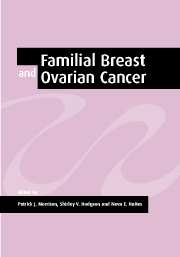Book contents
- Frontmatter
- Contents
- List of contributors
- Foreword by Helena Kennedy
- Preface
- Acknowledgements
- Part 1 Molecular biology and natural history
- Part 2 Screening
- Part 3 Management
- 15 Management of BRCA1/2 mutation carriers
- 16 Management of familial ovarian cancer
- 17 Prophylactic mastectomy in mutation carriers
- 18 Psychosocial aspects of genetic counselling for breast and ovarian cancer
- 19 BRCA1/2 testing: uptake and its measurement
- 20 Breast cancer genetics: ethical, social and insurance issues
- 21 Gene therapy for breast and ovarian cancer
- 22 Future directions
- Index
22 - Future directions
Published online by Cambridge University Press: 24 August 2009
- Frontmatter
- Contents
- List of contributors
- Foreword by Helena Kennedy
- Preface
- Acknowledgements
- Part 1 Molecular biology and natural history
- Part 2 Screening
- Part 3 Management
- 15 Management of BRCA1/2 mutation carriers
- 16 Management of familial ovarian cancer
- 17 Prophylactic mastectomy in mutation carriers
- 18 Psychosocial aspects of genetic counselling for breast and ovarian cancer
- 19 BRCA1/2 testing: uptake and its measurement
- 20 Breast cancer genetics: ethical, social and insurance issues
- 21 Gene therapy for breast and ovarian cancer
- 22 Future directions
- Index
Summary
It is abundantly clear from the contents of this book that our understanding of the inherited aspects of cancer has increased enormously in the past decade. Epidemiological studies (Easton et al., 1995) demonstrate that familial clusters of common cancers could be due to: (1) germline mutations in rare, highly penetrant cancer susceptibility genes, (2) more common, less penetrant mutations, or (3) common environmental factors. It is likely that all of these mechanisms are important. Subsequent to the identification of BRCA1 and BRCA2 (Miki et al., 1994; Wooster et al., 1995), large collaborative studies of families with hereditary breast and ovarian cancer suggest that currently detectable germline mutations in these genes account for approximately 85% of families with six cases of breast cancer but only 41% of those with four to five cases, most families with two ovarian cancer (in addition to breast cancer) cases but 88% (69% due to BRCA1 mutations) with only one ovarian cancer case, while 77% of families with four female cases and one male case of breast cancer are due to BRCA2 and 19% of such families to BRCA1 mutations (Easton et al., 1995; Ford et al., 1998; Thorlacius et al., 1998). Thus a significant proportion of smaller families, particularly those with no cases of ovarian cancer, are likely to be due to polymorphic variants in other genes.
- Type
- Chapter
- Information
- Familial Breast and Ovarian CancerGenetics, Screening and Management, pp. 384 - 392Publisher: Cambridge University PressPrint publication year: 2002



